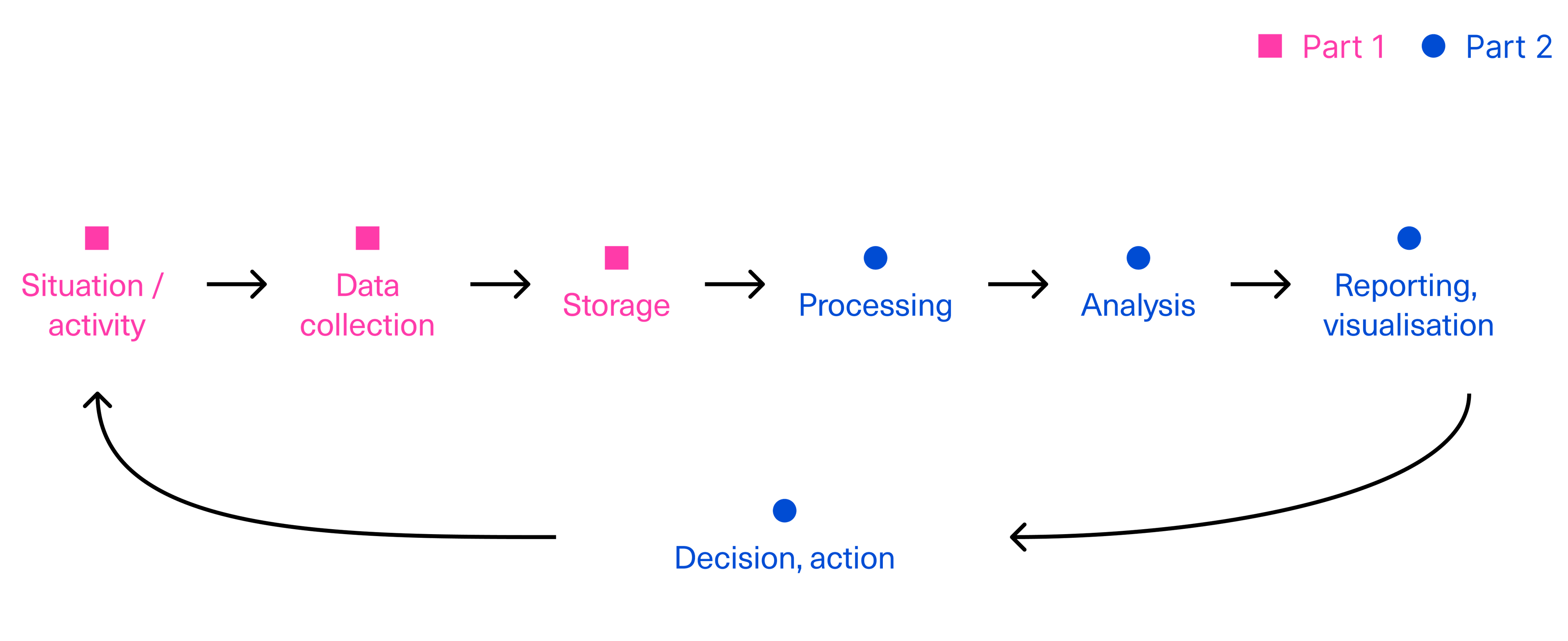The Data Life Cycle

Here are three numbers: 27, 92 and 93.
Do these mean anything to you? Probably not. But as soon as you know that the numbers represent the percentage of Norwegians aged 9-79 who used the Internet on an average day, in the years of 2000, 2020 and 2021 respectively, then the numbers become more interesting. To think that only one in four used the Internet on a daily basis in the year 2000! And to this day, not all Norwegians are online.
The point is that it makes little sense to talk about random numbers or values as data. Data must represent something, or be “about” something, to have value and to become information and knowledge. What this example shows is that data needs context.
This also reminds us that data has to come from somewhere. The numbers aren’t made up—they’re based on a specific situation or activity. Even for analogue data, such as a sound wave, there is something preceding it, producing the sound.
So, data is connected to the situations that they came from or that they relate to. It’s crucial to link data back to their original situation (context), or else the data might lose their potential value. This kind of contextual information should be reflected through metadata, which is essentially “data about data."
Fact
Metadata
Metadata means data about data. For example, in the gallery app on your phone, you can find data about where and when a picture was taken, what settings were used, number of pixels, file type, file size, and where the file is stored on the device. All of this is data about the picture. In other words, it is data about data, or metadata.
Another way to put it: Metadata is additional data that provides information about the interpretation of data.
The word “meta” is actually a prefix that comes from Greek and means between, after, or above. A metadiscussion is, for example, a discussion about or above a discussion; a metastudy brings together the results of previous studies; a metaworld is a world above a world. It’s no coincidence that Facebook, the company—as they plan a digital, synthetic VR world—has changed its name to Meta.
To understand how data works, and how it gives us insight and allows us to do new things, we must follow the data’s own journey. Along the way, the data is collected, stored, processed, and analysed—and maybe reported and visualised—before it is finally used for some purpose. This is the life cycle of data.

This model is based on an internationally established standard (defined by ISO, International Organization for Standardization) and is widely used in academia and business. But it can also be relevant to us as individuals when we seek insight from, for example, fitness watches and other IoT-supported devices (IoT is short for Internet of Things).
This is also relevant in relation to privacy and other contexts where we are interested in understanding who owns the data, how long they keep it, and what purposes it is used for.
What the lifecycle is, and what it looks like, is further explored in the boxes below.
The life cycle part 1: From situation to storage
Click to read about the different stages in the first part of the data life cycle, from data generation to collection and storage.
The life cycle part 2: From storage to action
Click to read about the different stages in the second part of the data life cycle, from storage to action.
Insight
The life cycle—data lives, but doesn’t die
We call this process the data life cycle. It’s a good metaphor—up to a certain point. Because, unlike a human being, the life cycle of data has no clear-cut beginning or end. Data is created, but that doesn’t mean it later dies.
Data can become inactive, it can be neglected, and it can become less relevant. But it is part of a continuous and ongoing process where it evolves, is used, and gives rise to new data production. And as long as it is stored and cared for, it can always be retrieved again and acquire new meaning and value.
Yes, it is simply “larger than life”, to quote the Backstreet Boys.
If you replace “love” with “data” in their song of the same name, it’s rather apt for the place of data in today’s world: “All you people can’t you see, can’t you see. How your data’s affecting our reality”.